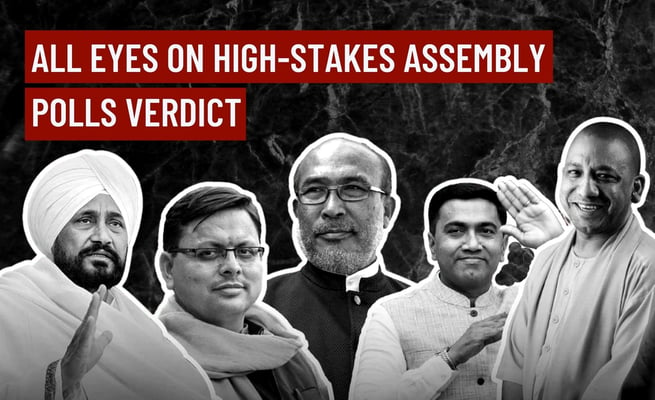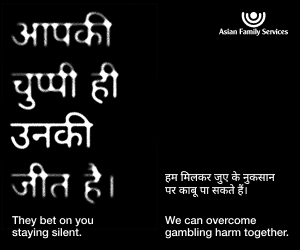All eyes on high-stakes assembly polls verdict

Around 115 million votes for 690 seats spread across five states will be counted on Thursday, concluding a poll exercise billed as a virtual semi-final for the 2024 general elections with implications on national politics and upcoming presidential elections.
The focus will be on Uttar Pradesh, where the Bharatiya Janata Party (BJP) is attempting to make history by becoming the first party to complete a full term and retain power in a generation.
The results in India’s most populous and politically crucial state – easily the biggest electoral prize after the Lok Sabha polls – will determine whether the BJP consolidates its position as the national political hegemon, or whether the Opposition can coalesce around a winning strategy. Exit polls indicate that the BJP is set to come back to power with a comfortable majority, pushing the Samajwadi Party (SP)-led alliance to a distant second place.
Also important will be the results in Punjab, where state politics was overshadowed by a year-long protest against three now-repealed central farm laws, but where exit polls now indicate that the Aam Aadmi Party (AAP), a fledgling outfit not even 10 years old, might get its first full state to rule and expand its national footprint outside Delhi after several unsuccessful forays in the past.
The counting of votes will begin at 8am at centres across the country that have been sanitised for Covid-19. With a special focus on Uttar Pradesh, the Election Commission of India has implemented a “three-layered security” to combat any form of “rumour mongering, disinformation and breach of protocol” during counting of votes, officials said. “Elaborate and foolproof arrangements have been made across the counting centres. All strong rooms, where polled EVMs are kept, are under three-layered security with inner cordon manned by central armed forces. Concerned candidates have been watching the strong room arrangements through CCTV coverage of 24x7,” EC secretary general Umesh Sinha said.
This round of elections – the largest exercise till the 2024 Lok Sabha polls – was announced in the shadow of the third wave of the pandemic, forcing the election commission to bar all physical campaigning initially, and relax curbs progressively over the next month. But high rates of vaccination – India had administered at least one dose to 96% of adults and fully inoculated 87.2% by the start of voting on February 10 – and the relatively mild Omicron variant of the coronavirus ensured that the election escaped the ravages of the Delta-hit 2021 state polls. In the end, turnout remained largely flat, with UP recording 60.8%, 0.31 percentage points below 2017.
The fiercest battle was fought in UP, where the BJP was challenged by an alliance led by the SP, and comprising the Rashtriya Lok Dal (RLD), Suheldev Bharatiya Samaj Party (SBSP) and smaller outfits. The Opposition engineered the defection of three senior ministers and around 10 lawmakers, and attempted to corner the government on unemployment, neglect of lower caste groups, poor Covid management and indifferent agriculture policies – especially in western UP, where farming communities such as Jats were at the core of the agitation against three central laws.
But the BJP countered this with the popularity of Prime Minister Narendra Modi, the strongman image of chief minister Yogi Adityanath, the efficiency in targeted delivery of welfare, deepening its outreach among small Other Backward Classes (OBC) and Dalit groups, and religious polarisation. The Bahujan Samaj Party (BSP) appeared outpaced for most of the campaign and focussed on its core base, Dalits, while the Congress, which ran a spirited campaign on women voters is expected to do poorly in the absence of ground-level cadre.
Most exit polls predicted that the BJP was set to return to power with a comfortable majority and the SP a distant second, despite an improved showing. In 2017, the BJP won 312 seats and around 40% of the votes – a feat considered impossible at the time – and two surveys indicated that the party will either retain this broad support, even improve upon it.
If the exit polls hold true, it will elevate Adityanath to the top echelons of national politics and one of the most important leaders of the BJP. It will boost the party’s morale ahead of the 2024 elections, reverse its recent trend of doing poorly in state elections and bolster its majority in the Rajya Sabha. It will also show that the party’s rainbow Hindu coalition is both durable and strengthened by the legions of welfare beneficiaries who may have voted for the party.
The results in Punjab may have greater bearing on the national Opposition space. In the state, where the BJP is a marginal player, the campaign was largely confined to the incumbent Congress, the AAP and the Akali Dal-BSP alliance. The BJP tied up with ousted chief minister Amarinder Singh’s Punjab Lok Congress but is expected to be limited to small pockets of influence.
The Congress gambled by installing Charanjit Singh Channi, the state’s first Dalit chief minister, four months before the elections, after a prolonged public spat between Singh and state party unit chief Navjot Singh Sidhu. But Channi was repeatedly undermined by Sidhu and the squabble was resolved only a week before the polls, when the party declared Channi as the CM candidate in a bid to consolidate the Dalit vote, roughly a third of the voter base. In contrast, the AAP – which came close to winning the 2017 elections only to falter in the closing stages – ran a more cohesive campaign focussed on exposing corruption and poor administration and declared Bhagwant Mann as its CM face fairly early.
Around 115 million votes for 690 seats spread across five states will be counted on Thursday, concluding a poll exercise billed as a virtual semi-final for the 2024 general elections with implications on national politics and upcoming presidential elections.
The focus will be on Uttar Pradesh,...
Around 115 million votes for 690 seats spread across five states will be counted on Thursday, concluding a poll exercise billed as a virtual semi-final for the 2024 general elections with implications on national politics and upcoming presidential elections.
The focus will be on Uttar Pradesh, where the Bharatiya Janata Party (BJP) is attempting to make history by becoming the first party to complete a full term and retain power in a generation.
The results in India’s most populous and politically crucial state – easily the biggest electoral prize after the Lok Sabha polls – will determine whether the BJP consolidates its position as the national political hegemon, or whether the Opposition can coalesce around a winning strategy. Exit polls indicate that the BJP is set to come back to power with a comfortable majority, pushing the Samajwadi Party (SP)-led alliance to a distant second place.
Also important will be the results in Punjab, where state politics was overshadowed by a year-long protest against three now-repealed central farm laws, but where exit polls now indicate that the Aam Aadmi Party (AAP), a fledgling outfit not even 10 years old, might get its first full state to rule and expand its national footprint outside Delhi after several unsuccessful forays in the past.
The counting of votes will begin at 8am at centres across the country that have been sanitised for Covid-19. With a special focus on Uttar Pradesh, the Election Commission of India has implemented a “three-layered security” to combat any form of “rumour mongering, disinformation and breach of protocol” during counting of votes, officials said. “Elaborate and foolproof arrangements have been made across the counting centres. All strong rooms, where polled EVMs are kept, are under three-layered security with inner cordon manned by central armed forces. Concerned candidates have been watching the strong room arrangements through CCTV coverage of 24x7,” EC secretary general Umesh Sinha said.
This round of elections – the largest exercise till the 2024 Lok Sabha polls – was announced in the shadow of the third wave of the pandemic, forcing the election commission to bar all physical campaigning initially, and relax curbs progressively over the next month. But high rates of vaccination – India had administered at least one dose to 96% of adults and fully inoculated 87.2% by the start of voting on February 10 – and the relatively mild Omicron variant of the coronavirus ensured that the election escaped the ravages of the Delta-hit 2021 state polls. In the end, turnout remained largely flat, with UP recording 60.8%, 0.31 percentage points below 2017.
The fiercest battle was fought in UP, where the BJP was challenged by an alliance led by the SP, and comprising the Rashtriya Lok Dal (RLD), Suheldev Bharatiya Samaj Party (SBSP) and smaller outfits. The Opposition engineered the defection of three senior ministers and around 10 lawmakers, and attempted to corner the government on unemployment, neglect of lower caste groups, poor Covid management and indifferent agriculture policies – especially in western UP, where farming communities such as Jats were at the core of the agitation against three central laws.
But the BJP countered this with the popularity of Prime Minister Narendra Modi, the strongman image of chief minister Yogi Adityanath, the efficiency in targeted delivery of welfare, deepening its outreach among small Other Backward Classes (OBC) and Dalit groups, and religious polarisation. The Bahujan Samaj Party (BSP) appeared outpaced for most of the campaign and focussed on its core base, Dalits, while the Congress, which ran a spirited campaign on women voters is expected to do poorly in the absence of ground-level cadre.
Most exit polls predicted that the BJP was set to return to power with a comfortable majority and the SP a distant second, despite an improved showing. In 2017, the BJP won 312 seats and around 40% of the votes – a feat considered impossible at the time – and two surveys indicated that the party will either retain this broad support, even improve upon it.
If the exit polls hold true, it will elevate Adityanath to the top echelons of national politics and one of the most important leaders of the BJP. It will boost the party’s morale ahead of the 2024 elections, reverse its recent trend of doing poorly in state elections and bolster its majority in the Rajya Sabha. It will also show that the party’s rainbow Hindu coalition is both durable and strengthened by the legions of welfare beneficiaries who may have voted for the party.
The results in Punjab may have greater bearing on the national Opposition space. In the state, where the BJP is a marginal player, the campaign was largely confined to the incumbent Congress, the AAP and the Akali Dal-BSP alliance. The BJP tied up with ousted chief minister Amarinder Singh’s Punjab Lok Congress but is expected to be limited to small pockets of influence.
The Congress gambled by installing Charanjit Singh Channi, the state’s first Dalit chief minister, four months before the elections, after a prolonged public spat between Singh and state party unit chief Navjot Singh Sidhu. But Channi was repeatedly undermined by Sidhu and the squabble was resolved only a week before the polls, when the party declared Channi as the CM candidate in a bid to consolidate the Dalit vote, roughly a third of the voter base. In contrast, the AAP – which came close to winning the 2017 elections only to falter in the closing stages – ran a more cohesive campaign focussed on exposing corruption and poor administration and declared Bhagwant Mann as its CM face fairly early.









Leave a Comment